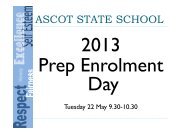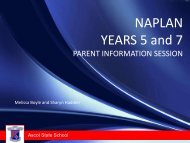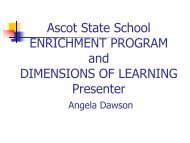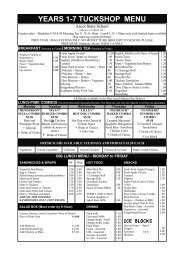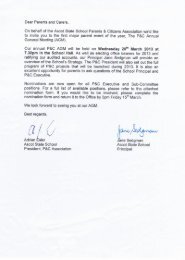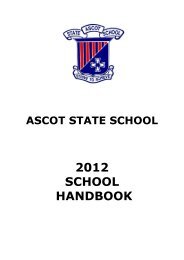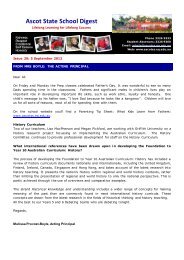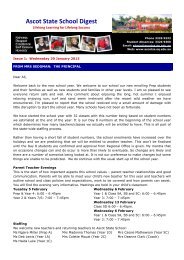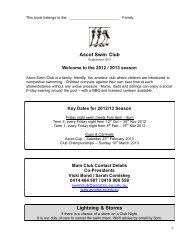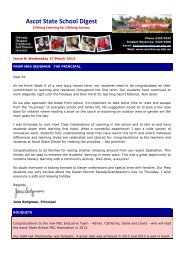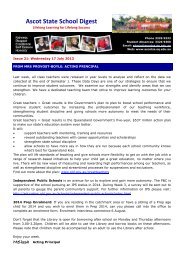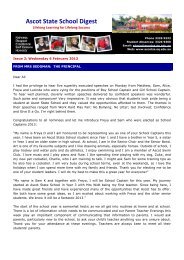Note 1 - Ascot State School
Note 1 - Ascot State School
Note 1 - Ascot State School
Create successful ePaper yourself
Turn your PDF publications into a flip-book with our unique Google optimized e-Paper software.
T<br />
DEPARTMENT OF EDUCATION, TRAINING AND EMPLOYMENT<br />
<strong>Ascot</strong> <strong>State</strong> <strong>School</strong> (0296)<br />
Queensland <strong>State</strong> <strong>School</strong> Reporting<br />
2012 <strong>School</strong> Annual Report<br />
YPEOVER TO INSERT SCHOOL NAME<br />
Postal address Pringle Street <strong>Ascot</strong> 4007<br />
Phone (07) 3326 9333<br />
Fax (07) 3326 9300<br />
Lifelong learning<br />
for lifelong success.<br />
Email<br />
Webpages<br />
Contact Person<br />
the.principal@ascotss.eq.edu.au<br />
Additional reporting information pertaining to Queensland state<br />
schools is located on the My <strong>School</strong> website and the Queensland<br />
Government data website.<br />
Jane Sedgman Principal<br />
Principal’s foreword<br />
Introduction<br />
The <strong>Ascot</strong> <strong>State</strong> <strong>School</strong> Annual Report is a document reporting on our school‟s activities and celebrations for the 2012 school year.<br />
This report demonstrates the successes achieved by a school community working together to provide quality education for its<br />
students.<br />
Our focus and successes in 2012 were:<br />
Explicit improvement in the teaching of Reading, Spelling, Numeracy<br />
All students‟ needs met through our school approach to differentiation<br />
Implementation of the Australian Curriculum – English, Maths, Science<br />
Use of NAPLAN- National Assessment Program Literacy and Numeracy data to improve students‟ achievements<br />
Implementation of the school‟s Strategic Plan 2012-2015<br />
Regional Showcase Winner for Academic Success<br />
Research has shown that two significant factors which lead to school and student achievement improvement are the quality of the<br />
teacher and the quality of the leadership. As such our coaching model of professional development continued in school and out of<br />
school to enhance our teaching and leadership practices.<br />
<strong>School</strong> progress towards its goals in 2012<br />
Implementation of Australian Curriculum in English, Maths and Science utilising adapted Curriculum to Classroom (C2C) units<br />
occurred. With the implementation changes were made to units of work as necessary. Significant collaboration between teaching<br />
teams ensured continuity and a smooth transition. The Australian Curriculum and C2C were implemented throughout all year levels<br />
and the necessary resources were purchased to support. C2C units incorporated new, challenging and engaging ICT learning<br />
experiences. The Library ordered and obtained C2C resources for year level use.<br />
Teachers planned classroom differentiation as demonstrated in individual teacher‟s planning. Significant collaboration in year level<br />
teams occurred to align planning, teaching and assessment. Assessment items were moderated and the data collected and<br />
analysed. We trialled the use of online assessment by engaging in the PAT Tests. The school implemented a whole school Reading<br />
and Maths assessment program – PAT R & M – to obtain data on all students from Year 2 upwards. Flexible timetabling in our<br />
Learning Support program allowed focussed teaching and learning in targeted year levels. An earlier timeframe for Prep reading<br />
commenced in Term 1 Week 6 and Prep phonics program began in Week 3.<br />
Friends of Visual Arts and Design (FOVAD) organised another very successful Art Show along with accompanying art lessons for<br />
each class and lunch time activities for students. To support the Visual Arts Program, approval to have an Artist-in-Residence was<br />
given for 2013 and the position was advertised. The <strong>School</strong>‟s Music Program continued to maintain its standard of excellence through<br />
musical evenings, musicals, instrumental and choir performances. The <strong>School</strong>‟s Dance Program conducted by the Footsteps Dance<br />
Company has been a very popular addition to The Arts Program.<br />
Resourcing of Science equipment was necessary to align with the implementation of the Australian Curriculum. Sustainability issues<br />
were reinforced with the visit from the Energy Van displaying and explaining alternative energy sources. Sustainability projects<br />
continued throughout the school, including paper recycling and the reintroduction of “Nude Food” Day.
DEPARTMENT OF EDUCATION, TRAINING AND EMPLOYMENT<br />
Queensland <strong>State</strong> <strong>School</strong> Reporting<br />
2012 <strong>School</strong> Annual Report<br />
The History/Study of Society and Environment (SOSE) Committee worked towards whole staff familiarisation of the Australian<br />
Curriculum-History in preparation for its 2013 implementation. All year levels included History/SOSE in their curriculum overviews.<br />
The Technology syllabus continued to be implemented and technology tasks within English, Maths and Science units were continued<br />
to be differentiated to meet various learning requirements of students. The school continued to implement the Lego Robotics Program<br />
in Term 3.<br />
The Sports Program ran sport development sessions for Years 4-7 between gala days to give students more opportunities to develop<br />
skills. Communication increased with parents about the Physical Education Program in the school newsletter. A changed format of<br />
the P-3 swimming carnival to 4 mini carnivals to address issues of overcrowding, noise, length of time between races proved<br />
successful. Year 3 students were included the in the athletics carnival which had previously been 4-7 in preparation for year 7<br />
students move to high school in 2015.<br />
Future outlook<br />
Key Directions of the Strategic Plan 2012-2015:<br />
Implementation of the Australian Curriculum<br />
<strong>School</strong> and Student Performance Data<br />
eLearning<br />
Community engagement and partnerships<br />
Early Childhood Education<br />
Middle Phase Education, particularly Year 7 to Secondary <strong>School</strong><br />
Sustainability<br />
Inclusive Education<br />
Student Diversity<br />
Differentiation<br />
Social/Emotional Wellbeing<br />
Review <strong>School</strong> Physical Education/Sport Program<br />
Develop Communications Strategy<br />
Develop P&C Strategic Plan 2012- 2015<br />
Selection in the Queensland Academies Partnership Program<br />
Continued school improvement through preparation for <strong>School</strong> Accreditation process<br />
Consideration for the school to apply to be an Independent Public <strong>School</strong><br />
Key features of the Independent Public <strong>School</strong>s initiative include:<br />
• enhanced local governance<br />
• opportunities for innovation<br />
• locally tailored workforce<br />
• increased financial flexibility<br />
Continuation of the school‟s Strategic Plan:
Our school at a glance<br />
<strong>School</strong> Profile<br />
Coeducational or single sex:<br />
Coeducational<br />
Year levels offered in 2012: Prep - Year 7<br />
Total student enrolments for this school:<br />
Enrolment Continuity<br />
Total Girls Boys<br />
(Feb – Nov)<br />
2010 750 363 387 93%<br />
2011 738 363 375 98%<br />
2012 766 376 390 97%<br />
Student counts are based on the Census (August) enrolment collection.<br />
Characteristics of the student body:<br />
Coeducational or single sex: Coeducational: Year levels offered: Prep - Year 7<br />
Total student enrolments for this school: 768 student numbers which determined our teacher numbers of 31 classroom teachers.<br />
Prep – 114 Year 1 - 121 Year 2 - 117 Year 3 - 114<br />
Year 4 – 121 Year 5 - 57 Year 6 - 70 Year 7 – 54<br />
<strong>School</strong> Disciplinary Absences: 0 x Short Suspensions - 1 to 5 days; Long Suspensions - 6 to 20 days, Exclusions.<br />
<strong>Ascot</strong> <strong>State</strong> <strong>School</strong> attracts a wide variety of students, most of whom reside in the catchment area. The school supports children with<br />
disabilities and those who are gifted academically, musically or in sporting ability. Students with English as a Second Language and<br />
refugee children are assisted by the many academic programs and specialised teachers. <strong>Ascot</strong> <strong>State</strong> <strong>School</strong> educates students from a<br />
wide variety of religious and cultural backgrounds, including many international families.<br />
Average Class sizes<br />
Average Class Size<br />
Phase<br />
2010 2011 2012<br />
Prep – Year 3 22 24 24<br />
Year 4 – Year 10 25 24 25<br />
<strong>School</strong> Disciplinary Absences<br />
Count of Incidents<br />
Disciplinary Absences<br />
2010 2011 2012<br />
Short Suspensions - 1 to 5 days 1 0 0<br />
Long Suspensions - 6 to 20 days 0 0 0<br />
Exclusions 0 0 0<br />
Cancellations of Enrolment 0 0 0
Our school at a glance<br />
Curriculum offerings<br />
Our distinctive curriculum offerings<br />
Dimensions of Learning (DoL) is used as the pedagogical framework for planning, teaching and assessing. The school has<br />
established links between the elements of Productive Pedagogies and Dimensions of Learning. This is the basis for developing a<br />
focussed learning community that develops intellectual quality and connectedness as well as recognition of difference and supportive<br />
school environment. Dimensions of Learning is a significant factor in the differentiation strategy of <strong>Ascot</strong> <strong>State</strong> <strong>School</strong>. It places<br />
students at the centre of what we do and promotes lifelong learning.<br />
DoL provides the best in instructional strategies, a structure for planning curriculum and assessment and has a focus on systemic<br />
reform. A major focus for differentiation in 2012 was the development of personal learning targets for all students. Teachers<br />
implemented the <strong>Ascot</strong> <strong>State</strong> <strong>School</strong> Higher Order Thinking Program to differentiate within their classrooms. Students developed<br />
their targets in Reading, Number and Social Skills. Also in 2012, teachers prepared themselves and their students for the<br />
implementation of the Australian Curriculum.<br />
A strong feature of the school is the Music Program which is supported by the instrumental music program and culminates in a Music<br />
Evening. There are three concert bands, a Senior choir and Junior choir and string ensembles. The Language Other Than English<br />
(LOTE) is Japanese. Students are involved in: Swimming Carnivals, Interschool Sports, Music on Sunday, Book Week, Senior and<br />
Junior Music Evenings and Urban Upbeat (band competition) at the Exhibition.<br />
Extra curricula activities<br />
Students participate in Years 4, 5 & 6 Camps, Year 7 Canberra Trip, excursions, ICAS Competitions (Year 3-7), The Young Scholar‟s<br />
Program (Year 5-7), High Achiever‟s Program (Year 6-7), Maths Tournament, Problem Solving Competition, Literacy Olympics<br />
Our students have access to an array of before and after school providers of clubs and special interest groups including French,<br />
Drama, Martial Arts, Swimming, Deportment and Music lessons. Our staff also has a broad range of expertise and individual passions<br />
that they enjoy sharing with our students. Teachers elect to run clubs and groups at lunch time and before and after school. In 2012<br />
these clubs included; Chess, Robotics, Friends Program, Science Club, Animation Club, Debating and Optiminds<br />
How Information and Communication Technologies (ICT) are used to assist learning<br />
Teachers accessed ICT to support the implementation of the Australian Curriculum. Examples of ICT accessed and used include:<br />
Learning Objects, Websites, C2C support materials, photographs and photo books, Youtubes, Powerpoints, emails, Ed Studios,<br />
<strong>School</strong> of Distance Education support materials and web conferences were also accessed by staff. Through the use of C2C<br />
materials, there has been a stronger focus on the embedding of ICT‟s.<br />
There was more interactive learning opportunities through the use of recently purchased hardware and software e.g. ipads, laptop<br />
computers. The purchase of iPads gave classes and teachers the chance to begin to explore mobile and digital collaborative work.<br />
The introduction of iPads in classrooms had a positive impact on student learning. Students were introduced to more challenging,<br />
motivating and new ICT‟s including Edstudios and multi-modal devices. These devices were a positive for differentiated learning and<br />
engaging our students.<br />
In the Music Program teachers integrated the use of ICTs through the use of CDs, DVDs, IPads, IPods, Data Projectors, YouTube<br />
clips and the H4 Zoom Handy Recorder to support their teaching. Filming and recording of lessons enhanced students‟ creative work.<br />
The short-throw projector has been used successfully for the <strong>School</strong> Musical for backdrop. The use of data projectors, Interactive<br />
Whiteboards, selected websites, YouTube clips, and software are all used to support student learning in Visual Arts and Media<br />
studies.<br />
All teachers used One <strong>School</strong> to enter student data. Reports were generated on One <strong>School</strong>. All staff received professional<br />
development to assist understanding and use of ICT‟s to enhance student learning. Power Point presentations regarding approaches<br />
within the new curriculum, and links to useful websites (for example QSA) were utilised as part of our staff awareness and in-service<br />
sessions. Some teachers commenced using the One <strong>School</strong> Markbook. Mathletics was available to every child for home and<br />
classroom use.<br />
Our Year 7 girls were involved in the Technology Takes You Anywhere (TTYA) Day, an ICT initiative for girls. A school program for<br />
our boys was developed involving interesting work with applications and animation. ICT devices were used by Special Education<br />
Program and Support Teachers.
Our school at a glance<br />
Social climate<br />
Our pastoral care program includes our Buddy System and Leadership Program. This involves all the Year 7 students as Senior<br />
Leaders supporting the younger students and demonstrating leadership in the Student Council, Early Act, Bio Box Monitors, <strong>School</strong>,<br />
Class, Sports Captains and Music Seniors positions. Senior students lead school events such as ANZAC Day Service, Year 7<br />
Graduation and Tabloid Sports for junior students.<br />
Leadership positions and the inclusion of buddy classes offered students in the middle years opportunities to develop healthy<br />
relationships and to become positive role models to our younger students. The Student Council and Early Act were active and<br />
supported many community corporations throughout the year. Early Act aimed to develop student‟s social and emotional well-being,<br />
whilst encouraging group work, organisational skills, and leadership and to develop positive voluntary contributions to society.<br />
Friendship Day was an initiative of the Student Council. Feedback from Friends program was positive and program was extended.<br />
Lunch Time Club was actioned to promote key relationships for students with disabilities.<br />
The Opinion Survey revealed the following data. Students reported a high level of satisfaction (<strong>School</strong> mean 92.9%) that teachers at<br />
this school treat students fairly. (<strong>State</strong> mean 81.7%, Like <strong>School</strong> mean 88%). Parents reported a high level of satisfaction that<br />
teachers at this school treat students fairly (100%) <strong>State</strong> mean (93.8 %) and Like <strong>School</strong> mean (90.7 %). The school has provided a<br />
safe, tolerant and disciplined learning involvement evidenced by the successful implementation of the Responsible Behaviour Plan<br />
and Social Skills Program. Students reported that they feel safe at school (<strong>School</strong> mean 98.8%, <strong>State</strong> mean 90.5% and Like <strong>School</strong><br />
mean 94.7%). Parents reported that their child is safe at this school (<strong>School</strong> mean 100%, <strong>State</strong> mean 95.3% and Like <strong>School</strong> mean<br />
97.3%). Students reported that they like being at their school (95.3%) with <strong>State</strong> mean 88.6% and Like <strong>School</strong> mean 92.9%.<br />
Students and parents enjoyed social activities such as Disco nights, Film Nights, Book Club, Welcome Drinks, Trivia Night, Biggest<br />
Morning Tea, Mother‟s Day Stall and Picnic, Father‟s Day Stall, Dad‟s Day Out BBQs, Assembly Morning Teas.<br />
Education Week was a great celebration of state education. A fabulous Assembly by 6/5 and 2E showcased Differentiation at <strong>Ascot</strong><br />
<strong>State</strong>. This work was the basis for our Regional Showcase Award submission for Academic Success. We enjoyed having Robbie<br />
Cooke (CEO wotif) for Principal for the Day. Robbie is an ex-student of <strong>Ascot</strong> <strong>State</strong> <strong>School</strong> and he loved being back at his primary<br />
school.<br />
Parent, student and staff satisfaction with the school<br />
There is a tremendous sense of community at <strong>Ascot</strong> <strong>State</strong> <strong>School</strong>. <strong>School</strong> traditions are held in high regard and parent involvement is<br />
high. Staff are committed, dedicated professionals and report a high level of satisfaction of working in the school.<br />
Performance measure (Nationally agreed items shown*)<br />
Percentage of parents/caregivers who agree that: 2012 #<br />
their child is getting a good education at school 100.0%<br />
this is a good school 100.0%<br />
their child likes being at this school* 100.0%<br />
their child feels safe at this school* 100.0%<br />
their child's learning needs are being met at this school* 96.7%<br />
their child is making good progress at this school* 100.0%<br />
teachers at this school expect their child to do his or her best* 100.0%<br />
teachers at this school provide their child with useful feedback about his or her school work* 100.0%<br />
teachers at this school motivate their child to learn* 100.0%<br />
teachers at this school treat students fairly* 100.0%<br />
they can talk to their child's teachers about their concerns* 100.0%
Our school at a glance<br />
this school works with them to support their child's learning* 100.0%<br />
this school takes parents' opinions seriously* 96.4%<br />
student behaviour is well managed at this school* 100.0%<br />
this school looks for ways to improve* 100.0%<br />
this school is well maintained* 96.7%<br />
Performance measure (Nationally agreed items shown*)<br />
Percentage of students who agree that: 2012 #<br />
they are getting a good education at school 98.8%<br />
they like being at their school* 95.3%<br />
they feel safe at their school* 98.8%<br />
their teachers motivate them to learn* 96.5%<br />
their teachers expect them to do their best* 100.0%<br />
their teachers provide them with useful feedback about their school work* 98.8%<br />
teachers treat students fairly at their school* 92.9%<br />
they can talk to their teachers about their concerns* 92.9%<br />
their school takes students' opinions seriously* 94.0%<br />
student behaviour is well managed at their school* 94.1%<br />
their school looks for ways to improve* 100.0%<br />
their school is well maintained* 96.5%<br />
their school gives them opportunities to do interesting things* 98.8%<br />
Performance measure (Nationally agreed items shown*)<br />
Percentage of school staff who agree: 2012 #<br />
that they have good access to quality professional development 91.7%<br />
with the individual staff morale items 96.7%<br />
* Nationally agreed student and parent/caregiver items were incorporated in the <strong>School</strong> Opinion Survey in 2012.<br />
# Percentage of respondents who Somewhat Agree, Agree or Strongly Agree with the statement. Due to changes to the <strong>School</strong> Opinion Surveys in 2012,<br />
comparisons with results for previous years are not recommended.<br />
DW = Data withheld to ensure confidentiality.
Our school at a glance<br />
Involving parents in their child’s education<br />
There has continued to be strong involvement from parents in a number of ways such as Friends of Visual Arts and Design, Friends<br />
of Music, the P&C, and parents of students involved with band, choir and instrumental programs. Parents engaged in the change to<br />
digital newsletters, accessed by 85% of those registered and the new Flexischool ordering system. They also engaged via their child<br />
with the use of Mathletics.<br />
Parents were invited to celebratory events such as class Celebration of Learning, musical evenings, assembly presentations which<br />
gave parents the opportunity to see their child‟s learning journey. Parents received end of semester reports and were offered<br />
opportunities to discuss their child‟s progress with the teacher. EdStudio was an important communication tool allowing parents,<br />
students, and teachers to an online communication environment in classrooms and homes.<br />
Consultation with staff and parents for the 2014 Years 6/7 school year occurred in preparation for Year 7 to high school move. The<br />
school conducted a Communication Review with Transition documents for parents developed. Parent information sessions were<br />
organized – ipads, Cybersmart and Professor Paula Barrett talk on Children in the 21 Century. Reading workshops were conducted<br />
that provided parents with strategies and information to improve student learning outcomes.<br />
Regular items were included in the school newsletter to inform parents of the implementation of the Australian Curriculum and schoolbased<br />
literary events e.g. Hip-Hop Poet, Young Writers‟ Festival and writing focus on narrative genre. Items regarding the new History<br />
Curriculum for 2013 were also included in the school newsletter.<br />
Parents were involved in the Physical Education program by the parent group reviewing aspects of the program, involvement in the<br />
perceptual motor program and swimming lessons and Swimming Carnivals (timekeeping, judging). The Special Education Program<br />
effectively shared planning strategies with parents of students with disabilities. Feedback from Friends Program was shared with<br />
parents. Parents assisted with the Japanese assembly and provided resources and knowledge in the classroom. Parent involvement<br />
in sustainability projects has been encouraged through advertising in the school newsletter and with regular reminders at assemblies.<br />
Community involvement continued throughout the school with the support from Bunnings, with Prep children creating a native garden<br />
and through the donation and setting up of a school worm farm.<br />
Reducing the school’s environmental footprint<br />
<strong>Ascot</strong> <strong>State</strong> <strong>School</strong> reduced its environmental impact in 2012 by consuming less electricity and water in 2011-12 than it did in 2010-<br />
11. The school actively worked to lower its consumption of electricity by turning off air-conditioning, lights and fans when<br />
unnecessary. Teachers led curriculum-based activities to raise awareness about energy use and the environment as well as the<br />
management of waste, with such initiatives as Wrapper-Free Wednesday. Ground staff maintained the pool, oval and gardens with<br />
minimal water usage, while maintaining safety standards and an awareness of the school‟s appearance.<br />
Environmental footprint indicators<br />
Electricity<br />
kWh<br />
Water kL<br />
2009-2010 237,843 4,505<br />
2010-2011 236,500 6,887<br />
2011-2012 225,760 3,965
Our staff profile<br />
Staff composition, including Indigenous staff<br />
2012 Workforce<br />
Composition<br />
Teaching<br />
Staff<br />
Non-teaching<br />
Staff<br />
Indigenous<br />
Staff<br />
Headcounts 51 22 0<br />
Full-time equivalents 43.9 13.5 0<br />
Qualifications of all teachers<br />
Highest level of<br />
attainment<br />
Number of<br />
classroom<br />
teachers and<br />
school leaders<br />
at the school<br />
Doctorate 0<br />
Masters 3<br />
40<br />
35<br />
30<br />
25<br />
20<br />
15<br />
10<br />
5<br />
0<br />
0 3<br />
36<br />
10<br />
2<br />
Bachelor degree 36<br />
Diploma 10<br />
Certificate 2<br />
Doctorate<br />
Bachelor degree<br />
Certificate<br />
Masters<br />
Diploma<br />
Expenditure on and teacher participation in professional development<br />
The total funds expended on teacher professional development in 2012 were $49 361.63<br />
The proportion of the teaching staff involved in professional development activities during 2012 was 100%.<br />
The major professional development initiatives are as follows:<br />
Staff professional development was undertaken in Reading, Writing, editing and proofreading. This resulted in consistent use of<br />
language, understanding and classroom practice across the school. All teachers received professional development on formative<br />
assessment and providing feedback to students. As a school we had a focus on providing differentiation for our C, D and E students<br />
All staff were provided with professional development on differentiation. Two teachers were recipients of the P&C Teacher<br />
Scholarship which focussed on ICTs.
Our staff profile<br />
Other professional development included workshops, conferences, seminars, web conferences and accessed professional<br />
development with outside providers when offered. The Maths Committee provided professional development to teachers on the topic<br />
of problem solving in order to develop a school wide language and approach. Teachers were in-serviced through the extensive<br />
background information supplied with the Australian Curriculum, in particular the C2C units. Strong peer tutoring occurred within year<br />
level teams to ensure that scientific understandings were clear amongst all teachers. Consistent high quality learning was<br />
demonstrated in the moderated assessment pieces and tasks. The Principal presented the work at <strong>Ascot</strong> SS in implementing the<br />
recommendations from the 2010 Audit findings at the ACER conference in Sydney.<br />
Teachers were involved in City Cluster Moderations and attended a Teacher Conference on the student free day in Term 4 which<br />
offered workshops in a wide range of topics such as spelling, ICTs, gifted and talented. Staff attended school based twilight sessions<br />
on a variety of topics. All staff participated in three familiarisation sessions revolving around History 2013. Key teachers attended two<br />
History conferences, a QSA workshop and a District HOC Day related to History. The school developed a relationship with the<br />
Griffith University to assist with our preparation for the implementation of the Australian Curriculum, History. Professional<br />
development with teachers was delivered by Paul Reitano, lecturer. Professional Development for Music has included ICT for Music<br />
(The Conservatorium), KEIMEA Conference, Kodaly/Orff Schulwerk PD (Ferry Rd Studios), and the Australian Curriculum Update<br />
(ABC Studios).<br />
Teachers continued to engage in obtaining Digital Pedagogical Licenses. There were also opportunities to develop professionally with<br />
the iPads via ICT mentors and One Channel webinars. Lunch time sessions were also offered for targeted needs. Staff were provided<br />
with professional development and support on the use of the markbook in One <strong>School</strong>.Other professional development occurred in:<br />
workshop on student wellness, several iPad workshops and webinars and significant professional development in the implementation<br />
of C2C and Australian Curriculum<br />
Physical Education professional development included: Swimming CARA, On field success – Athletic Performance, treating asthma,<br />
teaching Athletics Course, Teaching baseball, Level 1 Cricket Coaches course, Fundamental Movement Patterns.<br />
Professional development for Special Education teachers included Friends Club training, DSAQ conference, ICT summit for special<br />
education, supporting SWD in your class, social and emotional welfare of students and staff. The Japanese teacher completed four<br />
web conferences (Moderator courses), Apps/Elluminate one day seminar, two Edstudios/OneChannel courses, Free Apps One<br />
Channel course and the use of Edstudio to complete their DPL.<br />
Average staff attendance 2010 2011 2012<br />
Staff attendance for permanent and temporary staff and school leaders. 96% 96.2% 96%<br />
Proportion of staff retained from the previous school year<br />
From the end of the previous school year, 100% of staff was retained by the school for the entire 2012 school year.<br />
<strong>School</strong> income broken down by funding source<br />
<strong>School</strong> income broken down by funding source is available via the My <strong>School</strong> website at http://www.myschool.edu.au/.<br />
To access our income details, click on the My <strong>School</strong> link above. You will then be taken to the My <strong>School</strong> website with the following<br />
„Find a school’ text box.
Our staff profile<br />
Where it says ‘Search by school name’, type in the name of the school you wish to view, and select . Read and follow the<br />
instructions on the next screen; you will be asked to accept the Terms of Use and Privacy Policy before being given access to the<br />
school‟s My <strong>School</strong> entry web page.<br />
<strong>School</strong> financial information is available by selecting ‘<strong>School</strong> finances’ in the menu box in the top left corner of the school‟s entry<br />
web page. If you are unable to access the internet, please contact the school for a paper copy of income by funding source.
Performance of our students<br />
Key student outcomes<br />
Student attendance 2010 2011 2012<br />
The overall attendance rate for the students at this school (shown as a percentage). 95% 95% 95%<br />
The overall attendance rate in 2012 for all Queensland state Primary schools was 93%.<br />
Student attendance rate for each year level (shown as a percentage)<br />
Year<br />
1<br />
Year<br />
2<br />
Year<br />
3<br />
Year<br />
4<br />
Year<br />
5<br />
Year<br />
6<br />
Year<br />
7<br />
2010 94% 95% 95% 96% 95% 96% 96%<br />
2011 93% 95% 95% 95% 96% 95% 94%<br />
2012 94% 95% 96% 96% 95% 96% 95%<br />
DW = Data withheld to ensure confidentiality.<br />
Student Attendance Distribution<br />
The proportions of students by attendance range.<br />
Attendance:<br />
0% to
Performance of our students<br />
National Assessment Program – Literacy and Numeracy (NAPLAN) results – our reading, writing,<br />
spelling, grammar and punctuation, and numeracy results for the Years 3, 5, 7 and 9.<br />
Our reading, writing, spelling, grammar and punctuation, and numeracy results for the Years 3, 5, 7 and 9 are available via the My<br />
<strong>School</strong> website at http://www.myschool.edu.au/.<br />
To access our NAPLAN results, click on the My <strong>School</strong> link above. You will then be taken to the My <strong>School</strong> website with the following<br />
„Find a school’ text box.<br />
Where it says ‘Search by school name’, type in the name of the school whose NAPLAN results you wish to view, and select .<br />
Read and follow the instructions on the next screen; you will be asked to accept the Terms of Use and Privacy Policy before being<br />
able to access NAPLAN data.<br />
If you are unable to access the internet, please contact the school for a paper copy of our school‟s NAPLAN results.<br />
Achievement –Closing the Gap<br />
In 2012, there were three Indigenous students attending the school.<br />
Through the Closing the Gap initiative we:<br />
• establish and maintain a culture of teaching and learning that is inclusive of Indigenous students and facilitates their<br />
engagement and successful participation<br />
• ensure staff have the appropriate cross-cultural skills, knowledge and understanding to meet the educational needs of<br />
Indigenous students.



